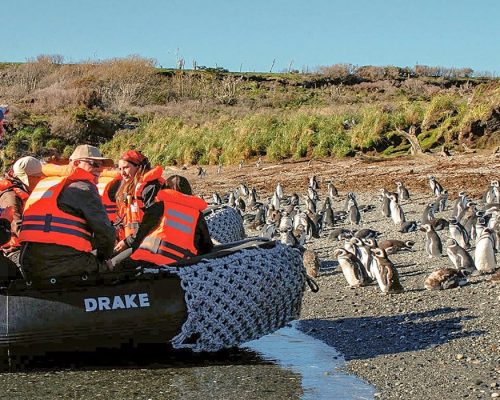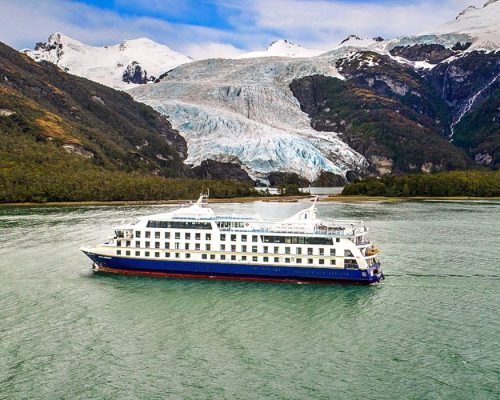



DARWIN'S ROUTE
Ushuaia
Book
Quote
Duration
9D / 8 N
Type
Program
Beginning of the experience
Arrive in Ushuaia, the southernmost town in the world, and board the M/V Ventus Australis (or M/V Stella Australis, depending on departure) at 6:00 pm. After a welcoming toast and introduction of captain and crew, the ship departs for one of the most remote corners of planet Earth. During the night you'll traverse the Beagle Channel and cross from Argentina into Chilean territorial waters. The lights of Ushuaia disappear as the ship turns into the narrow Murray Channel between Navarino and Hoste islands.
Around the break of dawn, the ship crosses Nassau Bay and enters the remote archipelago that comprises Cape Horn National Park. Weather and sea conditions permitting, you'll go ashore on the windswept island that harbors legendary Cape Horn (Cabo de Hornos). Discovered in 1616 by a Dutch maritime expedition—and named after the town of Hoorn in West Friesland—Cape Horn is a sheer 1,394-foot-high rocky promontory overlooking the turbulent waters of the Drake Passage. For many years it was the only navigation route between the Pacific and Atlantic, and was often referred to as the “End of the Earth.” The park was declared a World Biosphere Reserve by UNESCO in 2005. The Chilean navy maintains a permanent lighthouse on the island, staffed by a lightkeeper and his family, as well as the tiny Stella Maris Chapel and modern Cape Horn Monument (currently awaiting repair after being damaged by fierce winds). Sailing back across Nassau Bay, the ship anchors at fabled Wulaia Bay, one of the few places in the archipelago where the human history is just as compelling as the natural environment. Originally the site of one of the region's largest Yámana aboriginal settlements, the bay was described by Charles Darwin and sketched by Captain FitzRoy in the 1830s during their voyages on HMS Beagle. This area is also renowned for its mesmerizing beauty and dramatic geography. After a visit to the Australis-sponsored museum in the old radio station—which is especially strong on the Yámana people and European missionaries in the area—passengers have a choice of three hikes (of increasing degrees of difficulty) that ascend the heavily wooded mountain behind the bay. On all of these you stroll through an enchanted Magellanic forest of lengas, coigües, canelos, and ferns to reach panoramic viewpoints overlooking the bay.
Sail overnight around the western end of Tierra del Fuego via the very narrow Gabrial Channel, Magdalena Channel, and Cockburn Channel. After rounding the remote Brecknock Peninsula, the ship tacks eastward and enters the Beagle Channel again. By morning you are entering Pia Fjord and boarding the Zodiacs for a shore excursion to Pia Glacier. After disembarking, take a short hike to gain a panoramic view of the spectacular glacier, which extends from the mountaintops down to the sea or a longer much more difficult walk up a lateral moraine of the old Pia Glacier. No one knows for certain how the hulking mass of snow and ice got its feminine moniker, but one theory says it was named for Princess Maria Pia of Savoy (1847-1911), daughter of the Italian king. Making your way further west along the Beagle Channel, enter another long fjord and drop anchor near Garibaldi Glacier for another shore excursion. Garibaldi is one of only three glaciers in Patagonia gaining mass rather than staying the same or slowly shrinking. This time you'll hike through virgin Magellanic forest to a glacial waterfall, a towering wall of ferns and moss, and spectacular viewpoints looking down on the glacier and fjord. The walk is demanding—very steep, negligible trail, rough footing—and not for everyone. For those who choose to stay onboard, the captain will point the bow toward the beautiful sky-blue Garibaldi Glacier so everyone can enjoy the panoramic view from the upper decks.
Early in the morning, sail through the Cockburn Channel and enter Agostini Sound. From there it is possible to see the glaciers that descend from the middle of the Darwin Mountain Range, some of them reaching the water. This morning, you will disembark and go for an easy walk around a lagoon, which was formed by the melting of the Águila Glacier, and reach a spot right in front of that glacier with stunning views. In the afternoon, you will approach the Condor Glacier via Zodiac, and hopefully see some of the abundant Andean condors in the area.
After an overnight cruise through Magdalena Channel and back into the Strait of Magellan, the ship anchors off Magdalena Island, which lies about halfway between Tierra del Fuego and the Chilean mainland. Crowned by a distinctive lighthouse, the island used to be an essential source of supplies for navigators and explorers and is inhabited by an immense colony of Magellanic penguins. At the break of dawn, weather permitting, go ashore and hike a path that leads through thousands of penguins to a small museum lodged inside the vintage 1902 lighthouse. Many other bird species are also found on the island. In September and April—when the penguins dwell elsewhere—this excursion is replaced by a ride aboard Zodiacs to Marta Island to observe South American sea lions. After a short cruise south along the strait, arrive at Punta Arenas, where there is plenty to keep you busy for the day in the city. (Note: Camera extension poles are prohibited on Magdalena Island.) Reboarding the ship, the lights of Punta Arenas fade into the distance as you cross the Strait of Magellan and enter the Whiteside Canal between Darwin Island and Isla Grande de Tierra del Fuego.
By dawn the ship is sailing up Admiralty Sound between the snowcapped peaks of Karukinka and the fjords of Alberto de Agostini National Park. Go ashore at Ainsworth Bay with its copious bird life and elephant seals. Two guided hikes are available, both with excellent views of Marinelli Glacier and the Darwin Mountains. Leaving Ainsworth Bay, sail west to the Tuckers Islets for a close-up encounter with the 4,000 Magellanic penguins who nest there. Many other bird species also frequent the tiny landfalls. In September and April—when the penguins live elsewhere—this excursion is replaced by a beach walk to a glacier at Brookes Bay.
On an overnight sail, the ship retraces its route around the western end of Tierra del Fuego via the very narrow Gabrial Channel, Magdalena Channel, and Cockburn Channel. After rounding the remote Brecknock Peninsula, the cruise tacks eastward and enters the Beagle Channel again. By morning you are entering Pia Fjord and boarding the Zodiacs for another shore excursion to Pia Glacier. Back onboard the ship, continue east along the Beagle Channel through an area called Glacier Alley. Living up to its name, the passage features a number of impressive tidewater glaciers flowing down from the Darwin Mountains and Darwin Ice Sheet on the north shore. Most of them named after European countries—Holland, Italy, Germany, Spain, and France.
During the early morning, navigate the narrow Murray Channel between Navarino and Hoste islands and drop anchor at historic Wulaia Bay, one of the few places in the archipelago where the human history is just as compelling as the natural environment. Originally the site of one of the region's largest Yámana aboriginal settlements, the bay was described by Charles Darwin and sketched by Captain FitzRoy in the 1830s during their voyages on the HMS Beagle. This area is also renowned for its mesmerizing beauty and dramatic geography. After a visit to the Australis-sponsored museum in the old radio station—which is especially strong on the Yámana people and European missionaries in the area—you have a choice of three hikes (of increasing degrees of difficulty) that ascend the heavily wooden mountain behind the bay. On all of these you will be strolling through an enchanted Magellan forest of lengas, coigües, canelos, ferns, and other endemic fauna to reach a panoramic viewpoint overlooking the bay. Before leaving Wulaia Bay, drop something into the wooden mail barrel inside the museum—letters or postcards meant to be hand delivered by future travelers—an ancient mariner tradition revived by Australis. In the afternoon, cruise across Nassau Bay into the remote archipelago that includes Cape Horn National Park. Weather and sea conditions permitting, go ashore on the windswept island that harbors legendary Cape Horn (Cabo de Hornos). Discovered in 1616 by a Dutch maritime expedition—and named after the town of Hoorn in West Friesland—Cape Horn is a sheer 425-meter (1,394-foot) high rocky promontory overlooking the turbulent waters of the Drake Passage. For many years it was the only navigation route between the Pacific and Atlantic, and was often referred to as the "End of the Earth." The park was declared a World Biosphere Reserve by UNESCO in 2005. The Chilean navy maintains a permanent lighthouse on the island, staffed by a lightkeeper and his family, as well as the tiny Stella Maris Chapel and modern Cape Horn Monument.
Reservas
Quote
Program info
Duration
9 D / 8 N
Type
Program
Book
Quote
Mapa
Includes
- Accomodation
- Entry fees
- All the tours mentioned

